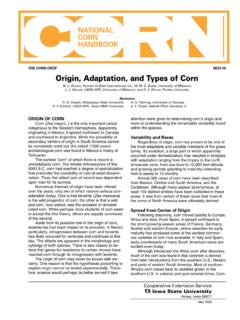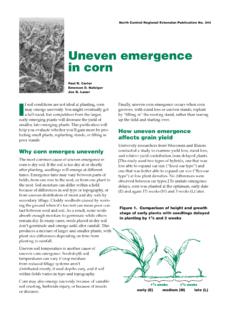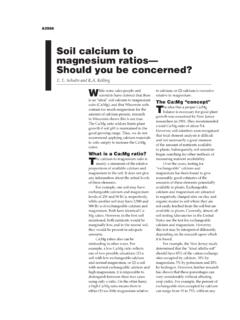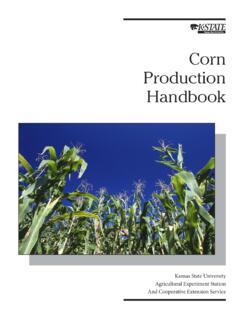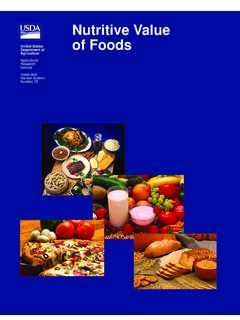Transcription of Corn Growth and Development
1 corn Growth and Development nth Leaf VE V1 V2 V4 V6 V10 V12 V14 Stage (Vn) VT R1 R2 R3 R4 R5 R6. Vegetative Reproductive corn Development Stages VE Emergence V14 Fourteen-Leaf R4 Dough Emergence occurs when the first leaves, Rapid Growth . This stage occurs Starchy material within the kernels has called the spike or the coleoptile, appear approximately two weeks before dough-like consistency (approximately above the soil surface. The seed absorbs flowering. Highly sensitive to heat and 26 to 30 days after R1). Rapid water (about 30% of its weight) and drought stress. Four to six extra leaves accumulation of starch and nutrients oxygen for germination. The radicle will expand from this stage until VT. occurs; kernels have 70% moisture root quickly emerges near the tip of the and begin to dent on the top.
2 Material kernel, depending on soil moisture and Management squeezed out of the kernel has dough- temperature conditions. The coleoptile Scout for root lodging issues, like consistency. emerges from the embryo side of the greensnap (likely to occur from V10 to kernel and is pushed to the soil surface VT) and diseases ( , common rust, Management by mesocotyl elongation. The mesocotyl brown spot). Abnormal corn ears can Stress can produce unfilled or shallow encloses the plumule leaves that open as occur and be obvious from this time kernels and chaffy ears. Impact of frost the structure approaches the soil surface. until flowering. on grain quality can be severe when it occurs at this stage (25 to 40% yield loss Management from light to killing frost, respectively). Ideal soil temperatures (50 to 55 degrees R4.)
3 Fahrenheit) and moisture conditions Vegetative promote rapid emergence (5 to 7 days). Optimum seed placement varies from V14 VT Tassel R5 Dent VE. 1 to 2 inches deep. Appropriate planting Most of the kernels are dented. Kernel Reproductive depth is critical for optimal emergence. Potential kernels per row is set, final potential grain number (number of moisture declines to approximately 55%. Cold, dry, and deep planting can delay (38 to 42 days after R1) as the starch emergence for several days. ovules), and potential ear size are being determined. Last branch of the content increases. tassel is visible at the top of the plant. Management V1 First-Leaf Silks may or may not have emerged. Stress can reduce kernel weight. Silage One leaf with collar visible (structure The plant is almost at its maximum harvest is approaching (at around 50%.)
4 Found at the base of the leaf ). The first height. kernel milk). leaf in corn has a rounded tip. From this point until flowering (R1 stage), leaf Management stages are defined by the uppermost Nutrient (K > N > P) and water ( R6 Maturity leaf with visible collars. The growing inch per day) demands for the crop are A black layer forms at the base of the close to maximum. Heat and drought R5. point is located below the surface until kernel, blocking movement of dry the late V5 stage. will affect potential number of kernels. matter and nutrients from the plant Scout for insects ( , corn leaf aphid, to the kernel (50 to 60 days after Management western bean cutworm, corn earworm, R1). Kernels achieve maximum dry Scout for proper emergence ( , 30 fall armyworm) and diseases ( , gray weight (30 to 35% moisture) and are plants in 171/2 feet for 30-inch row leaf spot, southern rust, northern leaf physiologically mature.
5 Spacing = 30,000 plants per acre), early- blight). Total leaf defoliation severely season weeds, insects, diseases, and affects final yields. Management other production issues. grain is not ready for safe storage. Frost VT or any biotic or abiotic stress does not impact yields after this Development V2 Second-Leaf R1 Silking stage. Lodging from disease, insect Nodal roots begin to emerge below Flowering begins when a silk is visible damage, or hail can result in physical ground. Seminal roots begin to senesce. outside the husks. The first silks to loss of yield. Harvest can proceed, but V1. Frost is unlikely to damage corn emerge from the husk leaves are recommended moisture for long-term seedling, unless it is extremely cold or those attached to potential kernels storage is Scout fields for ear R6 drop due to things such as European the corn was shallowly planted.
6 Near the base of the ear. Silks remain active until pollinated. Pollen falls from corn borer damage. Vegetative the tassel to the silks, fertilizing the Milk Line Progression Black Layer Yield Components of corn ovule to produce an embryo. Potential . V4 Fourth-Leaf kernel number is determined. milk milk milk Maximum plant height is achieved. line line line er Nodal roots are dominant, occupying Ke mb more soil volume than seminal roots. Following fertilization, cell division is rne l nu V2 grain lw Leaves still developing on apical occurring within the embryo. eig rne Dented Mature Yield meristem (primary Growth of the plant). Early Mid Late ht Ke Kernel. Kernel. Management Dent Dent Dent Black layer Black layer Nutrient (N and P accumulation is still Milk line progresses from the top of the not formed.)
7 Ears per area kernel (early dent) to the bottom (late dent). developed. progressing, K is almost complete) and water ( inch per day) demands Yield components and critical Growth stages for their definition in corn production. are at the peak. Heat and drought Yield Components V6 Sixth-Leaf will affect pollination and final grain Stage Potential Actual Six leaves with collar visible. The first number. Defoliation by hail or other VE Ears/area . leaf with the rounded tip is senescent;. consider this point when counting R1 factors such as insects will produce a large yield loss. V6. V12. Kernel rows/ear . Factory 3. Kernel rows/ear V4 leaves. The growing point emerges above the soil surface. All plant parts V18. R11, 2. Kernels/row Kernel weight . Kernel number Ears/area R1 to R5. are initiated.
8 Sometime between V6 R6 Kernel weight and V10, the potential number of rows 1 . Potential Kernel Weight = set when cell division takes place in the endosperm, 7 to 10 days after pollination (R1-R2 or the (ear girth) is determined. Potential row lag phase of the sigmoidal kernel Growth curve). R1 = potential kernel ovules and kernel number, if no stress is affecting pollination and final kernel Development . number is affected by genetics and 2. environment and is reduced by stress R2 Blister 3. Factory = After tassel initiation at V5, all corn plant parts are already developed to support ear and grain Development . Reproductive Silks darken and begin to dry out conditions. The plant increases in height Growth stages, moisture content, and total dry matter progression for corn during the (approximately 12 days after R1).
9 Reproductive due to stalk elongation; nodal roots are Kernels are white and blister-like in Average per Substage established in the lowest, below-ground shape and contain a clear fluid. Kernels Dry Matter (% of Growing nodes of the plant. R Stage Moisture % Days are approximately 85% moisture; Total Dry Weight) Degree Days, F. Management embryos develop in each kernel. 60 45 75 3. V6 Scout for weeds, insects, and diseases. Rapid nutrient uptake begins at this Cell division is complete. grain filling commences. (1/4 milk line). (1/2 milk line). 52. 40. 65. 90. 120. 175. 6. 10. (3/4 milk line) 37 97 205 14. stage. Timing nutrient applications to match this uptake enhances the Management (Physiological maturity) 35 100. Stress can reduce yield potential Abendroth, , Elmore, Boyer, and S. K.
10 Marlay. 2011. corn Growth and Development . PMR 1009. Iowa State Univ. 1 . potential for greater nutrient use Extension. Ames Iowa. by reducing final grain number efficiency, particularly for mobile (abortion). Ignacio A. Ciampitti, Crop Production and Cropping Systems Specialist, nutrients such as nitrogen. Department of Agronomy, Kansas State University. TWITTER V10 Tenth-Leaf R2 Roger W. Elmore, Cropping Systems Agronomist, Brace roots begin to develop in the Department of Agronomy and Horticulture, University of Nebraska-Lincoln. lower above-ground nodes of the plants. TWITTER @RogerElmore Until this stage, rate of leaf Development Joe Lauer, corn Specialist, is approximately 2 to 3 days per leaf. R3 Milk Department of Agronomy, University of Wisconsin. TWITTER @WiscCorn Management Silks dry out (approximately 20 days Nutrient (potassium = K > nitrogen = N after R1).)
